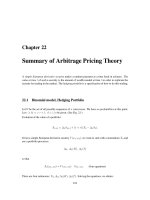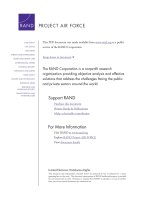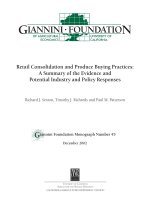Summary of Arbitrage Pricing Theory
Bạn đang xem bản rút gọn của tài liệu. Xem và tải ngay bản đầy đủ của tài liệu tại đây (191.73 KB, 10 trang )
Chapter 22
Summary of Arbitrage Pricing Theory
A simple European derivative security makes a random payment at a time fixed in advance. The
value at time
t
of such a security is the amount of wealth needed at time
t
in order to replicate the
security by trading in the market. The hedging portfoliois a specification of how to do this trading.
22.1 Binomial model, Hedging Portfolio
Let
be the set of all possible sequences of
n
coin-tosses. We have no probabilities at this point.
Let
r 0; ur+1;d=1=u
be given. (See Fig. 2.1)
Evolution of the value of a portfolio:
X
k+1
=
k
S
k+1
+1+rX
k
,
k
S
k
:
Given a simple European derivative security
V !
1
;!
2
, we want to start with a nonrandom
X
0
and
use a portfolio processes
0
;
1
H ;
1
T
so that
X
2
!
1
;!
2
=V!
1
;!
2
8!
1
;!
2
:
(four equations)
There are four unknowns:
X
0
;
0
;
1
H ;
1
T
. Solving the equations, we obtain:
223
224
X
1
!
1
=
1
1+r
2
6
6
4
1+ r ,d
u, d
X
2
!
1
;H
| z
V !
1
;H
+
u , 1 + r
u , d
X
2
!
1
;T
| z
V !
1
;T
3
7
7
5
;
X
0
=
1
1+r
1+r,d
u,d
X
1
H+
u, 1 + r
u , d
X
1
T
;
1
!
1
=
X
2
!
1
;H, X
2
!
1
;T
S
2
!
1
;H, S
2
!
1
;T
;
0
=
X
1
H, X
1
T
S
1
H, S
1
T
:
The probabilities of the stock price paths are irrelevant, because we have a hedge which works on
every path. From a practical point of view, what matters is that the paths in the model include all
the possibilities. We want to find a description of the paths in the model. They all have the property
log S
k+1
, log S
k
2
=
log
S
k+1
S
k
2
=log u
2
= log u
2
:
Let
= log u0
.Then
n,1
X
k=0
log S
k+1
, log S
k
2
=
2
n:
The paths of
log S
k
accumulate quadratic variation at rate
2
per unit time.
If we change
u
, then we change
, and the pricing and hedging formulas on the previous page will
give different results.
We reiterate that the probabilities are only introduced as an aid to understanding and computation.
Recall:
X
k+1
=
k
S
k+1
+1+rX
k
,
k
S
k
:
Define
k
=1+r
k
:
Then
X
k+1
k+1
=
k
S
k+1
k+1
+
X
k
k
,
k
S
k
k
;
i.e.,
X
k+1
k+1
,
X
k
k
=
k
S
k+1
k+1
,
S
k
k
:
In continuous time, we will have the analogous equation
d
X t
t
=td
St
t
:
CHAPTER 22. Summary of Arbitrage Pricing Theory
225
If we introduce a probability measure
f
IP
under which
S
k
k
is a martingale, then
X
k
k
will also be a
martingale, regardless of the portfolio used. Indeed,
f
IE
X
k+1
k+1
F
k
=
f
IE
X
k
k
+
k
S
k+1
k+1
,
S
k
k
F
k
=
X
k
k
+
k
f
IE
S
k+1
k+1
F
k
,
S
k
k
:
| z
=0
Suppose we want to have
X
2
= V
,where
V
is some
F
2
-measurable random variable. Then we
must have
1
1+r
X
1
=
X
1
1
=
f
IE
X
2
2
F
1
=
f
IE
V
2
F
1
;
X
0
=
X
0
0
=
f
IE
X
1
1
=
f
IE
V
2
:
To find the risk-neutral probability measure
f
IP
under which
S
k
k
is a martingale, we denote
~p =
f
IP f!
k
= H g
,
~q =
f
IP f!
k
= T g
, and compute
f
IE
S
k+1
k+1
F
k
=~pu
S
k
k+1
+~qd
S
k
k+1
=
1
1+r
~pu +~qd
S
k
k
:
We need to choose
~p
and
~q
so that
~pu +~qd =1+r;
~p+~q=1:
The solution of these equations is
~p =
1+r, d
u,d
; ~q =
u,1 + r
u , d
:
22.2 Setting up the continuous model
Now the stock price
S t; 0 t T
, is a continuous function of
t
. We would like to hedge
along every possible path of
S t
, but that is impossible. Using the binomial model as a guide, we
choose
0
and try to hedge along every path
S t
for which the quadratic variation of
log S t
accumulates at rate
2
per unit time. These are the paths with volatility
2
.
To generate these paths, we use Brownian motion, rather than coin-tossing. To introduce Brownian
motion, we need a probability measure. However, the only thing about this probability measure
which ultimately matters is the set of paths to which it assigns probability zero.
226
Let
B t; 0 t T
, be a Brownian motion defined on a probability space
; F ; P
.Forany
2 IR
, the paths of
t + Bt
accumulate quadratic variation at rate
2
per unit time. We want to define
S t=S0 expft + Btg;
so that the paths of
log S t = log S 0 + t + Bt
accumulate quadratic variation at rate
2
per unit time. Surprisingly, the choice of
in this definition
is irrelevant. Roughly, the reason for this is the following: Choose
!
1
2
. Then, for
1
2 IR
,
1
t + Bt; !
1
; 0 t T;
is a continuous function of
t
. If we replace
1
by
2
,then
2
t + Bt; !
1
is a different function.
However, there is an
!
2
2
such that
1
t + Bt; !
1
=
2
t+Bt; !
2
; 0 t T:
In other words, regardless of whether we use
1
or
2
in the definition of
S t
,wewillseethesame
paths. The mathematically precise statement is the following:
If a set of stock price paths has a positive probability when
S t
is defined by
S t=S0 expf
1
t + Btg;
then this set of paths has positive probability when
S t
is defined by
S t=S0 expf
2
t + Btg:
Since we are interested in hedging along every path, except possibly for a set of paths
which has probability zero, the choice of
is irrelevant.
The most convenient choice of
is
= r ,
1
2
2
;
so
S t=S0 expfrt + Bt ,
1
2
2
tg;
and
e
,rt
S t=S0 expfBt ,
1
2
2
tg
is a martingale under
IP
. With this choice of
,
dS t=rS t dt + St dB t
CHAPTER 22. Summary of Arbitrage Pricing Theory
227
and
IP
is the risk-neutral measure. If a different choice of
is made, we have
S t=S0 expft + Btg;
dS t=+
1
2
2
| z
S t dt + St dB t:
= rS t dt +
h
,r
dt + dB t
i
:
| z
d
e
B t
e
B
has the same paths as
B
. We can change to the risk-neutral measure
f
IP
, under which
e
B
is a
Brownian motion, and then proceed as if
had been chosen to be equal to
r ,
1
2
2
.
22.3 Risk-neutral pricing and hedging
Let
f
IP
denote the risk-neutral measure. Then
dS t= rS t dt + S t d
e
B t;
where
e
B
is a Brownian motion under
f
IP
.Set
t=e
rt
:
Then
d
S t
t
=
S t
t
d
e
B t;
so
S t
t
is a martingale under
f
IP
.
Evolution of the value of a portfolio:
dX t= tdS t+rXt,tS t dt;
(3.1)
which is equivalent to
d
X t
t
=td
St
t
(3.2)
=t
St
t
d
e
Bt:
Regardless of the portfolio used,
X t
t
is a martingale under
f
IP
.
Now suppose
V
is a given
F T
-measurable random variable, the payoff of a simple European
derivative security. We want to find the portfolio process
T ; 0 t T
, and initial portfolio
value
X 0
so that
X T = V
. Because
X t
t
must be a martingale, we must have
X t
t
=
f
IE
V
T
F t
; 0 t T:
(3.3)
This is the risk-neutral pricing formula. We have the following sequence:









